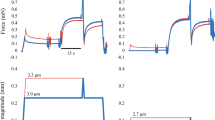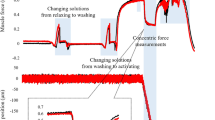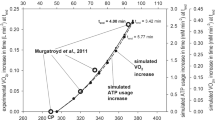Abstract
The power of shortening contractions in skeletal muscle is determined by the force-velocity relationship. Fatigue has been reported to either increase or decrease the force-velocity curvature depending on experimental circumstances. These discrepant findings may be related to experimental differences in oxygen availability. We therefore investigated how the curvature of the force-velocity relationship in soleus and gastrocnemius rat muscles is affected during fatigue, in both an ex vivo setup without an intact blood perfusion and in an in situ setup with an intact blood perfusion. Furthermore, we investigated the effect of reduced oxygen concentrations and reduced diffusion distance on the curvature of the force-velocity relationship in ex vivo muscles, where muscle oxygen uptake relies on diffusion from the incubation medium. Muscles were electrically stimulated to perform repeated shortening contractions and force-velocity curves were determined in rested and fatigued conditions. The curvature increased during fatigue in the soleus muscles (both in situ and ex vivo), and decreased for the gastrocnemius muscles (in situ) or remained unchanged (ex vivo). Furthermore, under ex vivo conditions, neither reduced oxygen concentrations nor reduced diffusion distance conferred any substantial effect on the force-velocity curvature. In contrast, reduced oxygen availability and increased diffusion distance did increase the loss of maximal power during fatigue, mainly due to additional decreases in isometric force. We conclude that oxygen availability does not influence the fatigue-induced changes in force-velocity curvature. Rather, the observed variable fatigue profiles with regard to changes in curvature seem to be linked to the muscle fiber-type composition.







Similar content being viewed by others
References
Allen DG, Lamb GD, Westerblad H (2008) Impaired calcium release during fatigue. J Appl Physiol (1985) 104:296–305. doi:https://doi.org/10.1152/japplphysiol.00908.2007
Ariano MA, Armstrong RB, Edgerton VR (1973) Hindlimb muscle fiber populations of five mammals. J Histochem Cytochem 21:51–55. https://doi.org/10.1177/21.1.51
Barclay CJ (1996) Mechanical efficiency and fatigue of fast and slow muscles of the mouse. J Physiol 497(Pt 3):781–794
Barclay CJ (2005) Modelling diffusive O(2) supply to isolated preparations of mammalian skeletal and cardiac muscle. J Muscle Res Cell Motil 26:225–235. https://doi.org/10.1007/s10974-005-9013-x
Bullimore SR, Saunders TJ, Herzog W, MacIntosh BR (2010) Calculation of muscle maximal shortening velocity by extrapolation of the force-velocity relationship: afterloaded versus isotonic release contractions. Can J Physiol Pharmacol 88:937–948. https://doi.org/10.1139/y10-068
Cairns SP, Hing WA, Slack JR, Mills RG, Loiselle DS (1997) Different effects of raised [K+]o on membrane potential and contraction in mouse fast- and slow-twitch muscle. Am J Phys 273:C598–C611. https://doi.org/10.1152/ajpcell.1997.273.2.C598
Curtin NA, Edman KA (1994) Force-velocity relation for frog muscle fibres: effects of moderate fatigue and of intracellular acidification. J Physiol 475:483–494
Devrome AN, MacIntosh BR (2007) The biphasic force-velocity relationship in whole rat skeletal muscle in situ. J Appl Physiol (1985) 102:2294–2300. https://doi.org/10.1152/japplphysiol.00276.2006
Devrome AN, MacIntosh BR (2018) Force-velocity relationship during isometric and isotonic fatiguing contractions. J Appl Physiol (1985) 125:706–714. https://doi.org/10.1152/japplphysiol.01119.2017
Edman KA (1988) Double-hyperbolic nature of the force-velocity relation in frog skeletal muscle. Adv Exp Med Biol 226:643–652
Eng CM, Smallwood LH, Rainiero MP, Lahey M, Ward SR, Lieber RL (2008) Scaling of muscle architecture and fiber types in the rat hindlimb. J Exp Biol 211:2336–2345. https://doi.org/10.1242/jeb.017640
Gilliver SF, Degens H, Rittweger J, Jones DA (2011) Effects of submaximal activation on the determinants of power of chemically skinned rat soleus fibres. Exp Physiol 96:171–178. https://doi.org/10.1113/expphysiol.2010.054239
Hill AV (1928) The diffusion of oxygen and lactic acid through tissues. Proceedings of the Royal Society of London Series B, Containing Papers of a Biological Character 104:39–96
Hill AV (1938) The heat of shortening and the dynamic constants of muscle. Proceedings of the Royal Society of London Series B - Biological Sciences 126:136–195. https://doi.org/10.1098/rspb.1938.0050
Jones DA, de Ruiter CJ, de Haan A (2006) Change in contractile properties of human muscle in relationship to the loss of power and slowing of relaxation seen with fatigue. J Physiol 576:913–922. https://doi.org/10.1113/jphysiol.2006.116343
Kristensen AM, Nielsen OB, Overgaard K 2018 Effects of manipulating tetanic calcium on the curvature of the force-velocity relationship in isolated rat soleus muscles. Acta Physiol (Oxf) 222(3) https://doi.org/10.1111/apha.12977
Kristensen AM, Nielsen OB, Pedersen TH, Overgaard K 2019 Fatiguing stimulation increases curvature of the force-velocity relationship in isolated fast-twitch and slow-twitch rat muscles. J Exp Biol 222(15). https://doi.org/10.1242/jeb.204545
MacIntosh BR, Holash RJ, Renaud JM (2012) Skeletal muscle fatigue--regulation of excitation-contraction coupling to avoid metabolic catastrophe. J Cell Sci 125:2105–2114. https://doi.org/10.1242/jcs.093674
Novák P, Zachařová G, Soukup T (2010) Individual, age and sex differences in fiber type composition of slow and fast muscles of adult Lewis rats: comparison with other rat strains. Physiol Res 59:783–801
Paradise NF, Schmitter JL, Surmitis JM (1981) Criteria for adequate oxygenation of isometric kitten papillary muscle. Am J Phys 241:H348–H353. https://doi.org/10.1152/ajpheart.1981.241.3.H348
Punkt K, Naupert A, Asmussen G (2004) Differentiation of rat skeletal muscle fibres during development and ageing. Acta Histochem 106:145–154. https://doi.org/10.1016/j.acthis.2003.11.005
Ranatunga KW (1982) Temperature-dependence of shortening velocity and rate of isometric tension development in rat skeletal muscle. J Physiol 329:465–483
Roy RR, Zhong H, Siengthai B, Edgerton VR (2005) Activity-dependent influences are greater for fibers in rat medial gastrocnemius than tibialis anterior muscle. Muscle Nerve 32:473–482. https://doi.org/10.1002/mus.20369
Soukup T, Smerdu V, Zacharova G (2009) Fiber type composition of unoperated rat soleus and extensor digitorum longus muscles after unilateral isotransplantation of a foreign muscle in long-term experiments. Physiol Res 58:253–262
Zhang SJ, Bruton JD, Katz A, Westerblad H (2006) Limited oxygen diffusion accelerates fatigue development in mouse skeletal muscle. J Physiol 572:551–559
Funding
This study was funded by the Aarhus University, Graduate School of Health at Aarhus University, as well as Helga and Peter Kornings Foundation (DC274023-KMU).
Author information
Authors and Affiliations
Contributions
Conceived of or designed the study: KO, AMK
Performed the research: KBM, BRM, AMK
Analyzed the data: BRM, AMK
Wrote and edited the paper: KBM, BRM, KO, AMK
Corresponding author
Additional information
Publisher’s note
Springer Nature remains neutral with regard to jurisdictional claims in published maps and institutional affiliations.
Rights and permissions
About this article
Cite this article
Kristensen, A.M., MacDougall, K.B., MacIntosh, B.R. et al. Is curvature of the force-velocity relationship affected by oxygen availability? Evidence from studies in ex vivo and in situ rat muscles. Pflugers Arch - Eur J Physiol 472, 597–608 (2020). https://doi.org/10.1007/s00424-020-02390-5
Received:
Revised:
Accepted:
Published:
Issue Date:
DOI: https://doi.org/10.1007/s00424-020-02390-5




